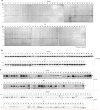Autophagic signatures in peripheral blood mononuclear cells from Parkinson's disease patients
- PMID: 39730076
- PMCID: PMC11786884
- DOI: 10.1016/j.mocell.2024.100173
Autophagic signatures in peripheral blood mononuclear cells from Parkinson's disease patients
Abstract
Parkinson's disease (PD) is a progressive neurodegenerative disorder characterized by motor impairments and the accumulation of misfolded α-synuclein. Dysregulation of the autophagy-lysosomal pathway (ALP), responsible for degrading misfolded proteins, has been implicated in PD pathogenesis. However, current diagnostic approaches rely heavily on motor symptoms, which occur due to substantial neurodegeneration, limiting early detection and intervention. This study investigated the potential of ALP-associated proteins in peripheral blood mononuclear cells (PBMCs) as diagnostic biomarkers for early-stage PD. Quantitative analysis revealed a significant reduction in optineurin levels in PBMCs from PD patients, and the expression levels of various ALP-associated proteins were tightly correlated, suggesting a coordinated dysregulation of the pathway. Correlation analyses revealed associations between ALP-associated features and clinical characteristics, such as age of onset and motor impairment. Furthermore, the study identified multiple positive correlations among ALP-associated proteins and functional readouts, highlighting the interconnectivity within the pathway. Notably, a PBMC biomarker model incorporating lysosomal-associated membrane protein 1 and optineurin exhibited high diagnostic accuracy (86%) in distinguishing PD patients from controls. These findings highlight the potential of ALP-associated protein signatures in PBMCs as novel diagnostic biomarkers for early detection and intervention in PD, offering insights into the systemic manifestations of the disease.
Keywords: Autophagy-lysosomal pathway; Biomarkers; Lysosomal-associated membrane protein 1; Optineurin; Parkinson’s disease.
Copyright © 2024 The Authors. Published by Elsevier Inc. All rights reserved.
Conflict of interest statement
DECLARATION OF COMPETING INTERESTS The authors declare that they have no known competing financial interests or personal relationships that could have appeared to influence the work reported in this paper.
Figures






References
-
- Athauda D., Foltynie T. The ongoing pursuit of neuroprotective therapies in Parkinson disease. Nat Rev Neurol. 2015;11:25–40. - PubMed
-
- Balducci C., Pierguidi L., Persichetti E., Parnetti L., Sbaragli M., Tassi C., Orlacchio A., Calabresi P., Beccari T., Rossi A. Lysosomal hydrolases in cerebrospinal fluid from subjects with Parkinson's disease. Mov Disord. 2007;22:1481–1484. - PubMed
-
- Balestrino R., Schapira A.H.V. Parkinson disease. Eur J Neurol. 2020;27:27–42. - PubMed
-
- Braak H., Del Tredici K., Rub U., de Vos R.A., Jansen Steur E.N., Braak E. Staging of brain pathology related to sporadic Parkinson's disease. Neurobiol Aging. 2003;24:197–211. - PubMed
MeSH terms
Substances
LinkOut - more resources
Full Text Sources
Medical
Research Materials

